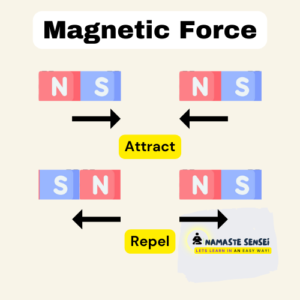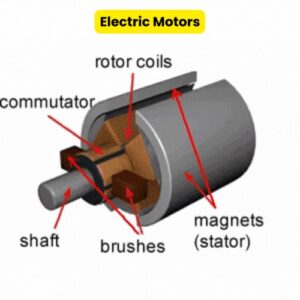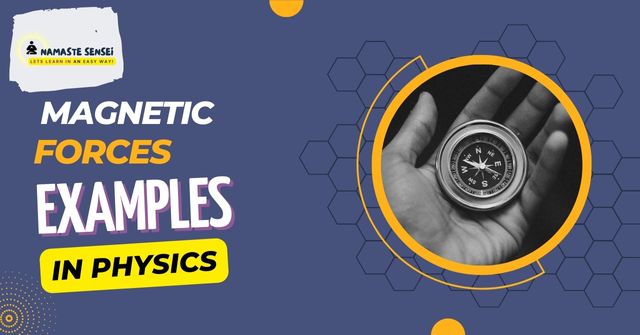Top 7 Magnetic Force Examples In Physics & Daily Life
Here are the top 7 Magnetic Force examples In Physics and real Life.
-
Compasses
-
Electric Motor
-
Magnetic Levitation (Maglev) Trains
-
MRI (Magnetic Resonance Imaging)
-
Hard Disk Drives
-
Magnetic Separators
-
Induction Cooktops
The force between two magnetic poles is called magnetic force. Magnetic forces are considered a subset of electromagnetic forces.
Electromagnetic force is one of the four fundamental forces of nature, along with gravity, the weak nuclear force, and the strong nuclear force. This article explores a diverse range of examples where magnetic forces play an important role.
But before you read any further, it might be a good idea to briefly understand, What are magnetic Forces. We will cover them very briefly. So it is recommended to read it, as it will help you to understand the examples better. If you are already familiar with the concept, you can skip it by clicking on the link below.
Skip to examples:
What are Magnetic Forces In Physics?

Magnetic force is the interaction between magnetic objects or moving charged particles. A moving charge produces both magnetic and electric fields.
Properties of magnetic forces:
-
Attraction and Repulsion: Magnetic forces can either attract or repel, depending on the alignment of magnetic poles. Like magnetic poles (N-N or S-S) repel each other, while opposite magnetic poles (N-S) attract each other.
-
Inversely Square Law: Similar to the electric force, the magnetic force follows an inverse square law. This means that the strength of the force decreases as the distance between magnetic objects increases. The force is inversely proportional to the square of the distance between them.
-
Field of Influence: Magnetic forces are associated with magnetic fields. These fields extend through space and influence any magnetic material or charged particle that enters them. The field lines indicate the direction and strength of the force.
-
Non-Contact Force: Magnetic forces can act on objects without physical contact, which is why magnets can attract or repel each other at a distance. This non-contact nature is particularly important in applications like magnetic levitation.
-
Induced Magnetism: Magnetic materials can become magnetized when exposed to an external magnetic field. Induced magnetism refers to the temporary or secondary magnetism that is produced in an object when it is brought into the influence of a magnetic field.
This can occur in materials that are typically non-magnetic, such as iron or steel when they are exposed to a strong external magnetic field. However, once the external magnetic field is removed, the induced magnetism in the material diminishes, and it typically reverts to a non-magnetic state.
Now let’s dive into our top 7 magnetic force examples in physics & daily life.
7 Magnetic Force examples in physics & daily life Explained
I am certain that the concept of magnetic force is clear to you now. If not, you can comment below. Let us now move on to our top 7 examples of the magnetic force in physics & in real life.
-
Compasses

Compass needles are usually made of ferromagnetic materials, which are inherently magnetic. The needle is usually balanced on a pivot so that it can rotate freely.
When a compass is at rest, its magnetic needle aligns itself with the Earth’s magnetic field. One end of the needle is the North-seeking pole (usually marked with an “N” or colored differently), and the other is the South-seeking pole.
By observing which end of the needle points to the North-seeking direction, you can determine the compass directions. The end pointing North indicates geographic North, while the other end indicates South.
Compasses are essential tools for navigation, as they accurately point to the Earth’s magnetic North Pole, allowing people to determine their direction. -
Electric Motors

Electric motors are devices that use magnetic forces to create motion. When you pass an electric current through a wire inside a magnetic field, it makes the wire move.
This movement is used to turn a part called the rotor, which, in turn, drives various machines like fans, cars, and appliances. Electric motors are all around us, making things work, and they showcase how magnetic forces can be harnessed to produce useful motion in our daily lives. -
Magnetic Levitation (Maglev) Trains

Magnetic Levitation (Maglev) trains are an advanced transportation technology that demonstrates the remarkable effects of magnetic forces. Instead of traditional wheels on tracks, Maglev trains use powerful magnets to lift the train slightly off the tracks.
These magnets create both lift and propulsion, allowing the train to glide smoothly and efficiently. By repelling against the tracks with strong magnetic forces, Maglev trains eliminate friction, resulting in higher speeds and a quieter, more comfortable ride.
This innovation showcases how magnetic forces can revolutionize the future of transportation by making trains faster, more energy-efficient, and environmentally friendly.
Recommended Read: How Mangalev Works? -
MRI (Magnetic Resonance Imaging)

Magnetic Resonance Imaging (MRI) is a medical imaging technology that relies on magnetic forces to create highly detailed images of the inside of the human body.
The MRI machine uses a strong magnetic field to make the atoms inside your body line up in the same direction. Then, it sends radio waves, which push these atoms out of position. When the radio waves stop, the particles go back to their original spots and send signals.
By measuring these signals, a computer constructs detailed images of the body’s internal structures. MRI is a valuable tool for diagnosing various medical conditions, from brain injuries to cancer.
-
Hard Disk Drives

Hard Disk Drives (HDDs) are data storage devices that rely on magnetic forces for reading and writing data. Inside an HDD, there are rapidly spinning magnetic disks (platters) coated with a magnetic material. When data is written, tiny magnetic regions on the platters are magnetized, representing binary information (0s and 1s).
To read the data, a read/write head, also using magnetic forces, detects the magnetic orientation of these regions. The interaction of these magnetic forces allows for the storage and retrieval of vast amounts of digital data on hard drives, a fundamental component of computers and data storage systems. -
Magnetic Separators

Magnetic separators are devices used in various industries to separate materials based on their magnetic properties. They work on the principle that some materials are attracted to magnets, while others are not.
When a mixture of materials passes through a magnetic separator, the magnetic components are attracted to the magnet and separated from the non-magnetic components.
This process is particularly useful in applications like recycling, mining, and food processing, where it’s essential to remove unwanted magnetic materials from a mixture, ensuring product quality and safety. -
Induction Cooktops

Induction cooktops are kitchen appliances that use magnetic forces to generate heat directly in cookware. They work through a process known as electromagnetic induction.
When you place a compatible pot or pan on the induction cooktop, an alternating current (AC) flows through a coil beneath the ceramic surface, creating a fluctuating magnetic field.
This magnetic field induces electric currents in the base of the cookware, heating it directly. The cookware, in turn, transfers the heat to the food.
Induction cooktops offer precise and efficient cooking, as they heat up quickly, respond rapidly to temperature adjustments, and ensure safety by not getting hot themselves.
References – Magnetic Force examples
- Khan Academy: Magnetic Force
If you are interested in learning about magnetic forces, this Khan Academy article could be a valuable educational resource to explore.
You have finished the complete article related to 7 Magnetic Force examples in physics & in daily life. If you have any doubts or queries, feel free to comment below. We will respond as soon as possible.
Or Email Us At [email protected]


